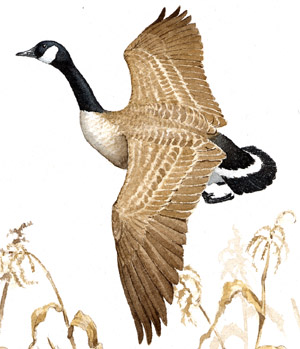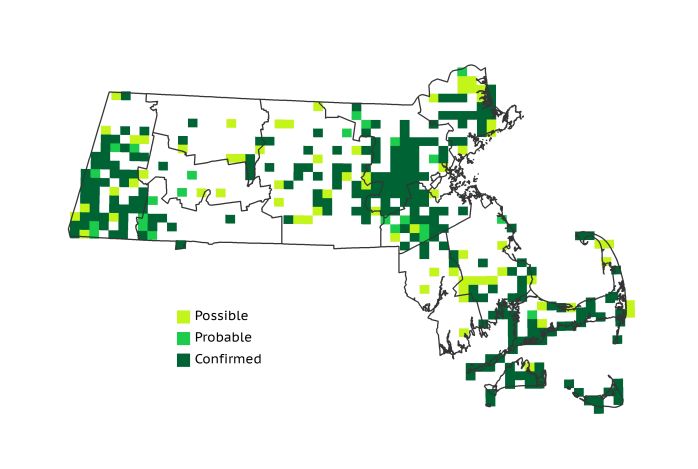Find a Bird
Canada Goose
Branta canadensis

Nearly ubiquitous and strongly increasing
“One swallow does not make a summer, but one skein of geese, cleaving the murk of a March thaw, is the spring.” – Aldo Leopold, A Sand County Almanac
Any Bay State resident living near a baseball field, a public park, or a body of water larger than the average road pothole knows Canada Geese. The loud honking of their large flocks makes them difficult to miss as they pass overhead. Such a glut of geese was not always the case in Massachusetts, however, since Canada Geese were once a fairly rare breeding species and were seen primarily on migration. For better or for worse, human intervention has radically altered the status of this species within the Bay State.
Historic Status
The recent success of Canada Goose in Massachusetts is attributable to both an increase in habitat and introduction by humans. The arrival of European settlers transformed much of the region’s forests to farmland, which is suitable habitat for the species, though Canada Geese still did not breed extensively in Massachusetts prior to 1900. The real increase came in the late 1930s after the use of live decoys for hunting was outlawed and hunters were forced to release the birds they had previously used for that purpose. Although by the middle of the twentieth century grasslands and farming in general were in decline in Massachusetts, there was still enough breeding habitat for Canada Geese to thrive. Within a few decades, Canada Geese had become widespread, sometimes being described as a nuisance. The redistribution of goslings from trouble areas to previously goose-free sections of the state in the 1960s made the invasion complete, and an explosion of golf course construction after Tiger Woods’ rise to prominence in the 1990s provided more than enough feeding and nesting habitat for Canada Geese for years to come.
Atlas 1 Distribution
In Atlas 1, Canada Geese occurred in disjunct pockets across the state. Though sparsely distributed in the Taconics, Canada Geese were more widely present in the western Marble Valleys and the Lower Berkshire Hills, perhaps due to birds moving in from New York and the Great Lakes. The Berkshire Highlands and Berkshire Transition had relatively few geese, and the Connecticut River Valley recorded a paltry 4 blocks despite seeming to represent excellent goose habitat. Canada Geese were only marginally more present across the Worcester and Lower Worcester Plateau than in the western highlands, but the parks and suburbs of the Coastal Plains hosted high densities of Canada Geese. Another odd gap existed in the Bristol/Narragansett Lowlands where one would have expected to find plenty of geese; however, Canada Geese had a strong presence on the Cape and Islands, occupying 55% of all blocks.
Atlas 2 Distribution and Change
Canada Geese continued their remarkable colonization of the state during the Atlas interval, and by Atlas 2 they were recorded in over 80% of all blocks. Only in the Taconics, Bristol Lowlands, and Cape Cod regions did this species occupy fewer than 80% of the blocks. One of the more remarkable aspects of the Canada Goose population in Massachusetts is its persistence. There were only 25 blocks where Canada Geese were detected in Atlas 1 but not in Atlas 2. Several of these blocks from which Canada Goose apparently vanished were located on the outer Cape and Islands, or in central Bristol County.
Atlas 1 Map

Atlas 2 Map

Atlas Change Map

Ecoregion Data
Atlas 1 | Atlas 2 | Change | ||||||
Ecoregion | # Blocks | % Blocks | % of Range | # Blocks | % Blocks | % of Range | Change in # Blocks | Change in % Blocks |
Taconic Mountains | 6 | 37.5 | 1.8 | 13 | 52.0 | 1.5 | 6 | 40.0 |
Marble Valleys/Housatonic Valley | 27 | 69.2 | 8.0 | 37 | 94.9 | 4.2 | 10 | 25.6 |
Berkshire Highlands | 15 | 27.3 | 4.5 | 44 | 80.0 | 5.0 | 27 | 50.9 |
Lower Berkshire Hills | 20 | 71.4 | 6.0 | 25 | 80.6 | 2.8 | 4 | 14.8 |
Vermont Piedmont | 2 | 11.8 | 0.6 | 14 | 82.4 | 1.6 | 8 | 66.7 |
Berkshire Transition | 7 | 18.4 | 2.1 | 32 | 80.0 | 3.6 | 19 | 61.3 |
Connecticut River Valley | 4 | 7.1 | 1.2 | 54 | 83.1 | 6.1 | 38 | 79.2 |
Worcester Plateau | 14 | 17.9 | 4.2 | 79 | 89.8 | 8.9 | 34 | 70.8 |
Lower Worcester Plateau | 13 | 17.6 | 3.9 | 75 | 93.8 | 8.5 | 43 | 79.6 |
S. New England Coastal Plains and Hills | 111 | 41.1 | 33.0 | 264 | 93.3 | 29.8 | 112 | 49.6 |
Boston Basin | 19 | 33.9 | 5.7 | 52 | 92.9 | 5.9 | 32 | 58.2 |
Bristol and Narragansett Lowlands | 23 | 21.7 | 6.8 | 85 | 74.6 | 9.6 | 56 | 55.4 |
Cape Cod and Islands | 75 | 55.1 | 22.3 | 112 | 77.8 | 12.6 | 24 | 20.0 |
Statewide Total | 336 | 34.7 | 100.0 | 886 | 85.4 | 100.0 | 413 | 49.8 |
Notes
Canada Geese show significant increasing Breeding Bird Survey trends in Massachusetts as well as in the Eastern US overall. The rapid colonization and notable shift in behavior of Canada Goose populations has created considerable controversy in Massachusetts as people try to contend with increasingly large flocks of geese. While stocks of some migratory populations of Canada Geese are declining, the rapidly increasing and largely nonmigratory populations have reached a point where game managers are allowing a broad, but controlled, take of this feral population of the species. Although these broad-season regulations may be harvesting as much as 25% of the resident goose population, that is not enough to stop the expansion of these nonmigratory birds. The nuanced differences between the nonmigratory and migratory populations of Canada Geese add to the complexity of helping citizens to understand that some Canada Goose populations are indeed declining.



